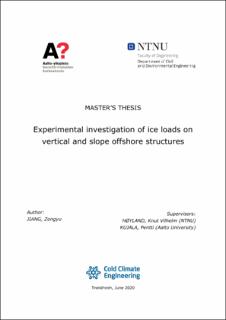| dc.description.abstract | An experiment was carried out to study the ice loads of level ice and ridge on the vertical and slope structures. The prototype of the model is the lighthouse Nordströmsgrund, which is a vertical structure and locates in the north Baltic sea. Nevertheless, a conical part was added to the model to study the ice load on slope structures in addition to the study of the ice loads on vertical structures. Three ice sheets with ridges were targeted to design the ice condition around Nordströmsgrund, including the flexural strength, ice thickness, geometrical cross-sectional profile of ridge, etc. Every ice sheet had a constant thickness, ranging from 0.04m to 0.043m in model-scale, but its flexural strength could be changed by using tempering procedure. Eight tests were successfully conducted and the ice loads were measured and recorded with three components divided according to the Cartesian coordinate system. The effect of ice properties and degrees of consolidation were also observed and analyzed with the measured data.
The history curve and its envelope were utilized to study the ice loads on structures. The ice loads were decomposed into rubble loads (loads induced by accumulated rubbles) and level ice/consolidated layer loads (loads induced by breaking the level ice/consolidated layer). The upper envelope was assumed to represent the total ice loads and the lower envelope was assumed to represent the rubble loads. Thus, the difference between the upper and lower envelopes could be considered the level ice/consolidated layer loads. Fast Fourier Transform was applied to study the energy distribution of ice loads. The splitting of level ice was observed in front of the ridge at three tests. The histogram and return period are employed to study the distribution of ice loads and affecting parameters.
The most important discovery of this research was that the horizontal range of rubbles moved by the structure had stronger influence on the ice ridge loads than the depth of rubble accumulation in front of the structure. Actually, the ridge loads were proportional to the volume of rubble accumulation and the strength of freeze bond in the keel. The zigzag pattern in the curve of horizontal range reflected the process of breaking the keel. This resulted in that the accumulation volume increased with a zigzag pattern in the curve of volume against the structure’s penetration distance into the ridge. | |
